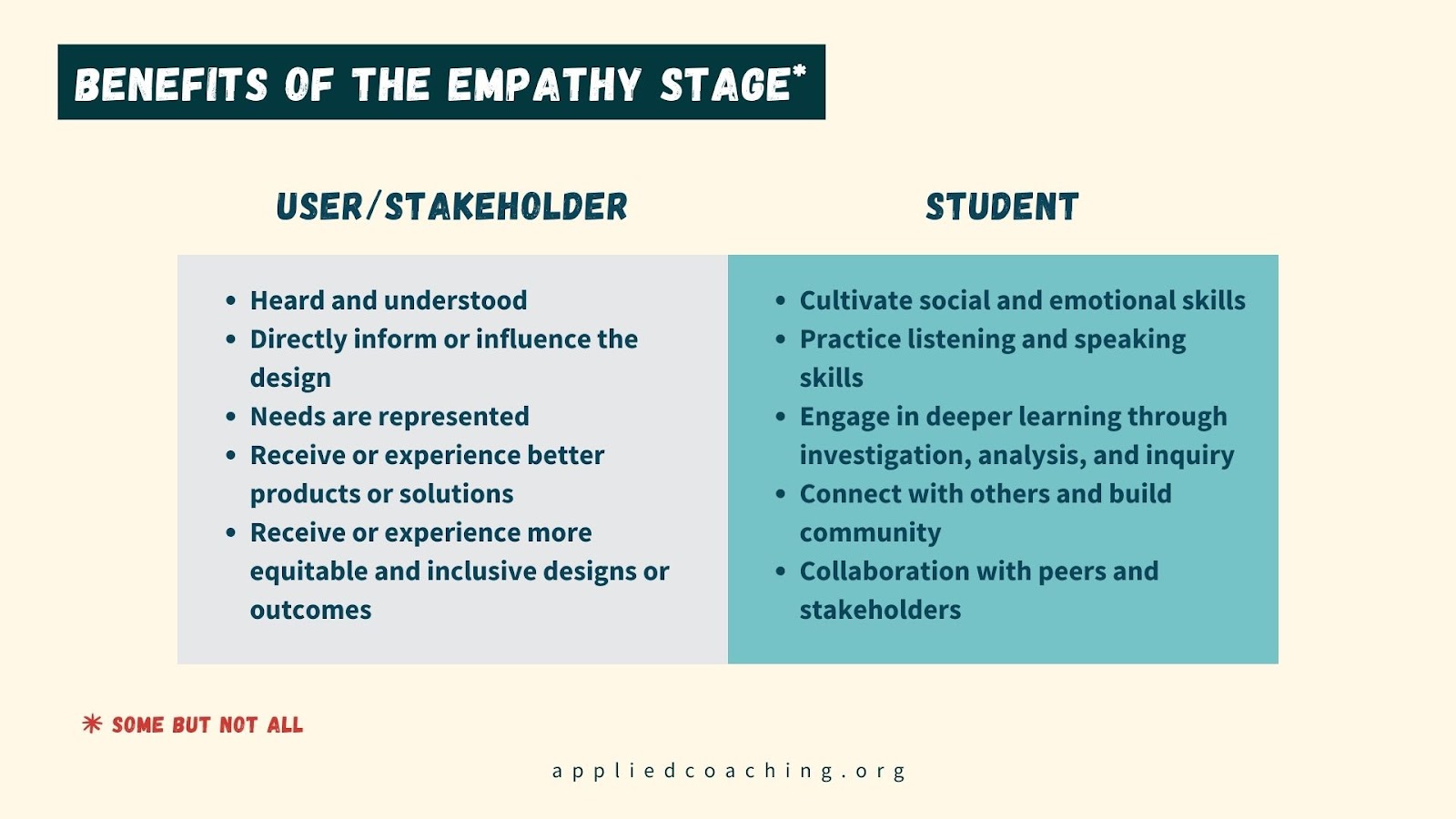“Empathy—the ability to understand and share the feelings of another.”
—Oxford Languages
Recently, I attended and facilitated sessions at the Association for International Schools in Africa’s (AISA) annual conference. Educators across the continent came together to deepen learning about belonging, well-being, and transformation. Many of these schools use an inquiry-based model or curriculum and were looking to level up their work. But how does inquiry promote belonging? Enter the human-centered design process and its superpower—empathy.
What is Human-centered Design? (A Brief Look)
There are many different takes on a human-centered design approach. Most of them have these basic elements.

Before launching a design thinking process, designers identify an issue or problem they want to explore. (Note: “Designers” will refer to the individuals leading the design thinking process.) Then, they move through the five (5) non-linear stages.
- Empathize - In this stage, designers take the time to identify and understand the needs, concerns, lived experiences, attitudes, feelings, and beliefs of stakeholders impacted by a particular issue or challenge. With this information, designers can understand the problem deeply.
- Define - Designers use what they learn in the empathy stage to articulate the problem. Defining the problem may also look like identifying a point of view or focus for the work.
- Ideate - With the problem clearly defined, time to generate ideas to address the defined problem or challenge! Be expansive here.
- Prototype - Time to choose an idea and make a prototype. The idea is to get the design out quickly for testing, so the prototypes are often a rapid sketch or made in a design sprint.
- Test - Time to test the prototype! The testing phase often leads to revisions and more questions. Designers return to other stages of the design thinking process to improve and refine their designs!
If you want to learn more, I recommend these models: Liberatory Design Thinking—National Equity Project (NEP); Equity Meets Design; IDEO; IxDF.
With this basic foundation in place, let’s zoom in on what I call the inquiry difference maker—empathy.
Empathy—sure, I have heard about that!
In human-centered design, empathy launches the process. It is the difference maker because it forces designers to look beyond their assumptions. Empathizing, in design thinking, connects designers and the people they are trying to serve. What does the user or stakeholder experience? What are their needs? What solutions have they already tried? What matters to them?
Designers empathize with their users in many ways—interviews, observations, surveys, case studies, and more. I will highlight some student-friendly ways to run the empathy process in just a bit. But first, why does empathy matter? Here are some benefits of incorporating empathy into your inquiry process.

How do I do this with my students?
Here are three tools to try out.
|
AEIOU
|
Empathy Maps
|
The 5 Whys
|
|
These are not just vowels! The AEIOU framework cultivates essential habits of mind when conducting observations.
A - Activities
E - Environments
I - Interactions
O - Objects
U - Users
|
These are visual representations of a particular user or stakeholder.
There are many different types of empathy maps. The one offered here is among the simplest and most user-friendly for a K-12 audience.
This map asks, what does the user see, feel, think, or do?
|
The founder of Toyota invented this process, which is still used at Toyota today!
“The method is remarkably simple: when a problem occurs, you drill down to its root cause by asking "Why?" five times. Then, when a counter-measure becomes apparent, you follow it through to prevent the issue from recurring.” (MindTools, n.d.)
Children are practically born asking this question. Leverage that curiosity!
|
For those not directly working with students, consider using one of these approaches in a professional learning session, a learning walk or classroom observation, or even an action research project!
What’s next?
Using empathy in the classroom helps to promote social and emotional learning (SEL) skills. Learn more about SEL in our free e-book—SEL Connected: Accessible Strategies to Bridge Social and Emotional Learning to Everyday Content.
Design thinking is also a part of the High Quality Project Based Learning (HQPBL) framework. Check out HQPBL Connected: An Educator's Guide to Creating Meaningful Project-based Student Experiences is available at our site and on Amazon in Kindle and print formats. If you’d like to learn more about our team of project-based learning experts, visit our site!
Try out one of these approaches, and let us know what you think! What resonated with you? What would modifications might you make for your learners?
Share your reflections or celebrate the work you are doing with students with us on Twitter or Facebook!
About the Author
Dr. Gina Olabuenaga is a professional learning designer and facilitator for K–12 educators. Her areas of expertise include project-based learning, social and emotional learning, and other constructivist practices. Her professional life has been an extension of her doctoral study on effective professional learning. As the former Director of Curriculum at PBLWorks, she led and supported the design and facilitation of workshops and services. Along with her partners at ACP, she has written 3 books: Connecting Together: Collaboration Strategies for Online and Physically Distanced Learning, SEL Connected: Accessible Strategies to Bridge Social and Emotional Learning to Everyday Content, and their latest, HQPBL Connected: An Educator's Guide to Creating Meaningful Project-based Student Experiences. You can find Gina on Twitter @OlaDoctorGina or at www.appliedcoaching.org.